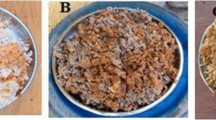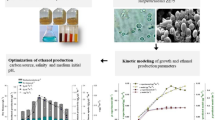Abstract
Lincomycin is one of the most poorly degradable antibiotics in solid wastes from the fermentation process. Discharging solid wastes without appropriate treatment can indirectly threaten human health. To treat the lincomycin residuals in solid wastes effectively, some yeast strains with high degradation capabilities against lincomycin were screened from the environment in this study. The degradation efficiency of the most highly active strain, S9, reached 37 %. This strain was identified as Galactomyces geotrichum. The significance of this study lies in the biotransformation of solid wastes.




Similar content being viewed by others
References
Arora PK, Kumar M, Chauhan A, Raghava GP, Jain RK (2009) OxDBase: a database of oxygenases involved in biodegradation. BMC Res Notes 2:67
Bragulat MR, Abarca ML, Cabanes FJ (2001) An easy screening method for fungi producing ochratoxin A in pure culture. Int J Food Microbiol 71:139–144
Chaudhry GR, Cortez L (1988) Degradation of bromacil by a Pseudomonas sp. Appl Environ Microbiol 54:2203–2207
Chaudhry GR, Huang GH (1988) Isolation and characterization of a new plasmid from a Flavobacterium sp. which carries the genes for degradation of 2,4-dichlorophenoxyacetate. J Bacteriol 170:3897–3902
Choi KH, Im SU, Kim CS, Choi SH, Kim CK (2004) Effect of the carbon dioxide laser on the clinical parameters and crevicular IL-1beta when used as an adjunct to gingival flap surgery. J Int Acad Periodontol 6:29–36
Diaz E (2004) Bacterial degradation of aromatic pollutants: a paradigm of metabolic versatility. Int Microbiol 7:173–180
du Toit EA, Rautenbach M (2000) A sensitive standardized micro-gel well diffusion assay for the determination of antimicrobial activity. J Microbiol Methods 42:159–165
Felsenstein J (1985) Confidence limits on phylogenies: an approach using the bootstrap. Evolution 39:783–791
Filtenborg O, Frisvad JC (1980) A simple screening method for toxigenic moulds in pure cultures. Lebensm Wiss Technol 13:128–130
Filtenborg O, Frisvad JC, Svendsen JA (1983) Simple screening method for molds producing intracellular mycotoxins in pure cultures. Appl Environ Microbiol 45:581–585
Fisher PR, Appleton J, Pemberton JM (1978) Isolation and characterization of the pesticide-degrading plasmid pJP1 from Alcaligenes paradoxus. J Bacteriol 135:798–804
Gavalchin J, Katz SE (1994) The persistence of fecal-borne antibiotics in soil. J AOAC Int 77:481–484
Ingerslev F, Halling-Sorensen B (2000) Biodegradability properties of sulfonamides in activated sludge. Environ Toxicol Chem 19:2467–2473
Kimura M (1980) A simple method for estimating evolutionary rates of base substitutions through comparative studies of nucleotide sequences. J Mol Evol 16:111–120
Kumar MS, Kumar PM, Sarnaik HM, Sadhukhan AK (2000) A rapid technique for screening of lovastatin-producing strains of Aspergillus terreus by agar plug and Neurospora crassa bioassay. J Microbiol Methods 40:99–104
Kummerer K (2003) Significance of antibiotics in the environment. J Antimicrob Chemother 52:5–7
Kuo MS, Yurek DA, Coats JH, Chung ST, Li GP (1992) Isolation and identification of 3-propylidene-delta 1-pyrroline-5-carboxylic acid, a biosynthetic precursor of lincomycin. Jpn J Antibiot 45:1773–1777
Kurtzman CP, Robnett CJ (1998) Identification and phylogeny of ascomycetous yeasts from analysis of nuclear large subunit (26S) ribosomal DNA partial sequences. Antonie Van Leeuwenhoek 73:331–371
Lell B, Kremsner PG (2002) Clindamycin as an antimalarial drug: review of clinical trials. Antimicrob Agents Chemother 46:2315–2320
Li XB, Zhao GR, Zheng H, Yuan YJ (2007) Improved industrial fermentation of lincomycin by phosphorus feeding. Process Biochem 42:662–668
Makimura K, Murayama SY, Yamaguchi H (1994) Detection of a wide range of medically important fungi by the polymerase chain reaction. J Med Microbiol 40:358–364
Nakase T, Suzuki M (1986) Bullera megalospora, a new species of yeast forming large ballistospores isolated from dead leaves of Oryza sativa, Miscanthus sinensis, and Sasa sp. in Japan. J Gen Appl Microbiol 32:225–240
Niewerth H, Schuldes J, Parschat K, Kiefer P, Vorholt JA, Daniel R, Fetzner S (2012) Complete genome sequence and metabolic potential of the quinaldine-degrading bacterium Arthrobacter sp. Rue61a. BMC Genomics 13:534
Pestka S (1977) Inhibitors of protein synthesis. In: Weissbach H, Pestka S (eds) Molecular mechanisms of protein biosynthesis. Academic, New York, pp 467–453
Randhawa GK, Kullar JS (2011) Bioremediation of pharmaceuticals, pesticides, and petrochemicals with gomeya/cow dung. ISRN Pharmacol 2011:362–459
Runsey TS, Miller RW, Dinius DA (1977) Residue content of beef feedlot manure after feeding diethylstilbestrol, chlortetracycline and Ronnel and the use of stirofos to reduce population of fly larvae in feedlot manure. Arch Environ Contam Toxicol 6:203–212
Saitou N, Nei M (1987) The neighbor-joining method: a new method for reconstructing phylogenetic trees. Mol Biol Evol 4:406–425
Semenova LE, Sherstobitova TS, Gorokhova IB (1994) The development of a technology for lincomycin biosynthesis with batch-type feeding of the substrates during the process. Antibiot Khimioter 39:3–8
Spizek J, Rezanka T (2004a) Lincomycin, clindamycin and their applications. Appl Microbiol Biotechnol 64:455–464
Spizek J, Rezanka T (2004b) Lincomycin, cultivation of producing strains and biosynthesis. Appl Microbiol Biotechnol 63:510–519
Thiele-Bruhn S (2003) Pharmaceutical antibiotic compounds in soils—a review. J Plant Nutr Soil Sci 166:145–167
Thompson JD, Gibson TJ, Plewniak F, Jeanmougin F, Higgins DG (1997) The CLUSTAL_X windows interface: flexible strategies for multiple sequence alignment aided by quality analysis tools. Nucleic Acids Res 25:4876–4882
Timmis KN, Steffan RJ, Unterman R (1994) Designing microorganisms for the treatment of toxic wastes. Annu Rev Microbiol 48:525–557
van der Meer JR, de Vos WM, Harayama S, Zehnder AJ (1992) Molecular mechanisms of genetic adaptation to xenobiotic compounds. Microbiol Rev 56:677–694
Vazquez D (1974) Inhibitors of protein synthesis. FEBS Lett 40(Suppl):S63–S84
Watanabe N, Bergamaschi BA, Loftin KA, Meyer MT, Harter T (2010) Use and environmental occurrence of antibiotics in freestall dairy farms with manured forage fields. Environ Sci Technol 44:6591–6600
Wetzstein HG, Schmeer N, Karl W (1997) Degradation of the fluoroquinolone enrofloxacin by the brown rot fungus Gloeophyllum striatum: identification of metabolites. Appl Environ Microbiol 63:4272–4281
White TJ, Bruns T, Lee S, Taylor JW (1990) Amplification and direct sequencing of fungal ribosomal RNA genes for phylogenetics. In: Innis MA, Gelfand DH, Sninsky JJ, White TJ (eds) PCR protocols: a guide to methods and applications. Academic, San Diego, pp 315–322
Wicklow D (1992) The coprophilous fungal community: an experimental system. In: Carrol GC, Wicklow DT (eds) The fungal community. Its organisation and role in the ecosystem, 712th edn. Marcel Dekker, New York, pp 715–728
Wicklow DT, Detroy RW, Jessee BA (1980) Decomposition of lignocellulose by Cyathus stercoreus (Schw.) de Toni NRRL 6473, a “white rot” fungus from cattle dung. Appl Environ Microbiol 40:169–170
Yarrow D (1998) Methods for the isolation, maintenance and identification of yeasts. In: Kurtzman CP, Fell JW (eds) The yeasts, a taxonomic study, 4th edn. Elsevier, Amsterdam, pp 77–100
Acknowledgments
The research was supported by the National Natural Science Foundation of China (31100104), the grant of Important Foundation of He’nan Educational Committee (12A180020) and the Foundation for University Key Youth Teacher by Henan Province, China.
Author information
Authors and Affiliations
Corresponding author
Additional information
The authors Lin Zhang and Yanli Shen contributed equally to the work.
Electronic supplementary material
Below is the link to the electronic supplementary material.
ESM 1
(DOCX 58 kb)
Rights and permissions
About this article
Cite this article
Zhang, L., Shen, Y., Hui, F. et al. Degradation of residual lincomycin in fermentation dregs by yeast strain S9 identified as Galactomyces geotrichum . Ann Microbiol 65, 1333–1340 (2015). https://doi.org/10.1007/s13213-014-0971-3
Received:
Accepted:
Published:
Issue Date:
DOI: https://doi.org/10.1007/s13213-014-0971-3




